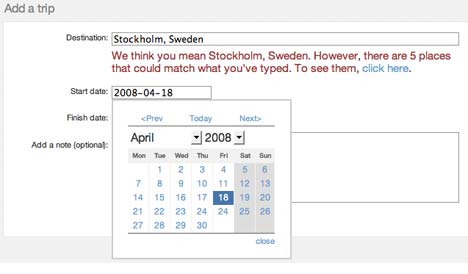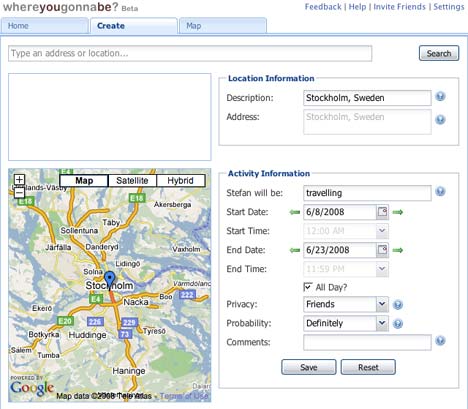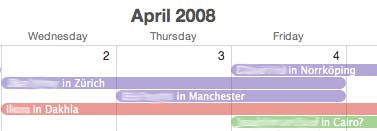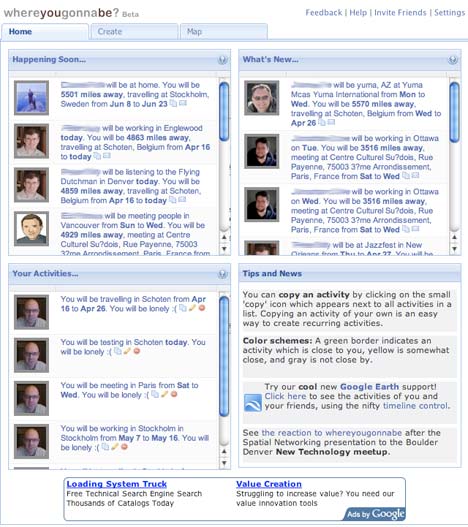Earlier this week, Peter Batty released whereyougonnabe (beta), a Facebook application that lets you expose your planned whereabouts to friends, and which lets you follow friends, so you’ll never have a near miss again.
In terms of functionality, it competes most closely with Dopplr, a standalone application with a Facebook module that has the same objective.
I already use Dopplr on Facebook, so it was easy to make a comparison. The upshot: Dopplr is simpler to use, while whereyougonnabe is more full-featured. Which you end up using will depend on your needs (and those of your friends).
In Dopplr, it takes no time at all to add a new “trip”. Just type a city, which gets recognized on the fly, click on start- and end dates, and you’re set. It is simplicity itself.

whereyougonnabe takes longer, but you have more options: Instead of just cities you can define addresses were you’ll be, instead of just dates you can define times, and you can specify the probability of the trip taking place. But you are forced to say what you will be doing there (you have no choice), so I wish it would have “travelling” as a default rather than throw a spanner in the submission process if I leave the field empty.

Dopplr and whereyougonnabe have different strategies when it comes to how you expose your future whereabouts. whereyougonnabe is a Facebook application, so your possible audience is your Facebook friends, all Facebook users, or just you (where you are told of serendipities but others are not). With Dopplr, you choose which other individual Dopplr users can see your trips — and if you install the Facebook module, then so can all your friends.
Where whereyougonnabe truly shines is what it does with the information. Dopplr uses the information of its users to generate a mini newsfeed of who is where — it doesn’t really leverage this information in geospatially interesting ways. whereyougonnabe, on the other hand, is literally all over the map: You can get a view on Google Maps with icons for where your friends will be, and the pièce the resistance is a timeline-enabled KML network link that draws your route and those of your friends, and keeps it updated.
whereyougonnabe’s visual representations work really well for me. To be honest, so does Dopplr’s simple newsfeed, as I am generally able to figure out myself that if somebody is in Ottawa and I am in Paris, that we’re unlikely to meet up. Dopplr’s RSS and iCal feed output is also very handy and fits into my exisiting schemes of keeping tabs on friends (Dopplr’s feed in purple below):

Where I find whereyougonnabe gets a bit heavy is when it squeezes the geosocial graph for every last bit of info and for every friend: It’s too much effort to read for every user, for example, that:
[xxxxx] will be working at Health Canada, 70 Colombine Drwy, Ottawa, ON, Canada from 7:45 AM to 4:00 PM on Tue. You will be 3516 miles away, meeting at Centre Culturel SuÔøΩdois, Rue Payenne, 75003 3ÔøΩme Arrondissement, Paris, France from Sat to Wed
I’d rather be alerted by proximity alerts than by a wall of text in which the meeting possibilities are hidden. The visual representations on maps and as KML cut through the clutter, but here too it would be cool to highlight close encounters via some kind of color code. At the moment, the home screen has a lot of clutter, which works against usability — Dopplr, on the other hand, subscribes to the “less is more” philosophy, which works well for me.

whereyougonnabe’s home page.
But Dopplr has recently also cashed in on an advertising agreement with an outfit called Mr & Mrs. Smith, and of late my every interaction with Dopplr includes some kind of exposure to luxury boutique hotels of the kind that I would never contemplate staying at at my travel destination. It’s an intrusive case of misdirected advertising, and as such comprises a sudden and rather strong pollutant of the experience. whereyougonnabe’s Google ads are far less intrusive, and very sustainable (at least to me).
Some more small stuff: I use kilometers as a measure of distance, not miles, and would like a setting to change that. In any case, precise as-the-bird-flies distances are not very meaningful, I feel. (And a beta bug report: accented characters need fixing:-)
Dopplr doesn’t lock itself into Facebook, but is independent of it, which is a good thing. I’m only using Facebook until something better comes along, and because I’ve been developing some mini apps for my employer, the Swedish Institute (Swedish Word of the Day, anyone?) to better understand the platform. Going forward, we at SI are commissioning a web application that is separate from Facebook, but which outputs via modules to all sorts of current and future formats and platforms, including Facebook, Flash widgets, RSS, email, iPhone… If a new platform reaches critical mass, we’ll have a new module built. I think this is going to be the ubiquitous development model for the next few years. Fortunately Batty knows this:
Our application currently runs on the Facebook Platform. The big advantage of this is that you don’t need to re-enter your network of friends, you can just leverage the existing social graph that you have in Facebook. In future we will support other social and business networking systems – LinkedIn is an obvious target for the business traveler, and of course OpenSocial is on our list too.
I think that in the long run it makes sense to be platform agnostic on this.
In sum, I very much like whereyougonnabe, though I suspect its biggest enemy is going to be my laziness, and that of my friends. If it can simplify the interface, shorten the input process and perhaps offer an XML output option, then the superior map visualization features will make it a winner.
Stefan, thanks for the very thorough review and the good suggestions, which we will make sure we put on our list! One point of clarification is that we do have color coding to indicate close encounters, I suspect maybe you don’t have any of them yet? So anyway, we agree with that idea :). I’ve written a few more detailed comments back at my blog.